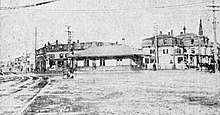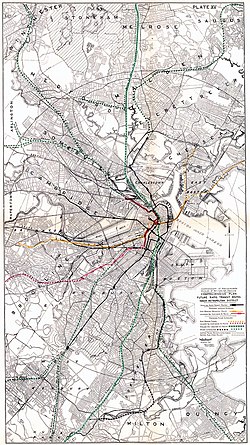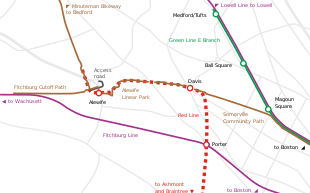Former rail line in Massachusetts, US
| Fitchburg Cutoff | |||||||||||||||||||||||||||||||||||||||||||||||||||||||||||||||||||||||||||||||||||||||||||||||||||
|---|---|---|---|---|---|---|---|---|---|---|---|---|---|---|---|---|---|---|---|---|---|---|---|---|---|---|---|---|---|---|---|---|---|---|---|---|---|---|---|---|---|---|---|---|---|---|---|---|---|---|---|---|---|---|---|---|---|---|---|---|---|---|---|---|---|---|---|---|---|---|---|---|---|---|---|---|---|---|---|---|---|---|---|---|---|---|---|---|---|---|---|---|---|---|---|---|---|---|---|
 The Fitchburg Cutoff east from Highland Road in 1953 The Fitchburg Cutoff east from Highland Road in 1953 | |||||||||||||||||||||||||||||||||||||||||||||||||||||||||||||||||||||||||||||||||||||||||||||||||||
| Overview | |||||||||||||||||||||||||||||||||||||||||||||||||||||||||||||||||||||||||||||||||||||||||||||||||||
| Owner | Boston and Maine Railroad | ||||||||||||||||||||||||||||||||||||||||||||||||||||||||||||||||||||||||||||||||||||||||||||||||||
| Termini |
| ||||||||||||||||||||||||||||||||||||||||||||||||||||||||||||||||||||||||||||||||||||||||||||||||||
| Stations | 3 | ||||||||||||||||||||||||||||||||||||||||||||||||||||||||||||||||||||||||||||||||||||||||||||||||||
| History | |||||||||||||||||||||||||||||||||||||||||||||||||||||||||||||||||||||||||||||||||||||||||||||||||||
| Opened | 1870, 1881 | ||||||||||||||||||||||||||||||||||||||||||||||||||||||||||||||||||||||||||||||||||||||||||||||||||
| Closed | 1979–80, 1983, 2007 | ||||||||||||||||||||||||||||||||||||||||||||||||||||||||||||||||||||||||||||||||||||||||||||||||||
| Technical | |||||||||||||||||||||||||||||||||||||||||||||||||||||||||||||||||||||||||||||||||||||||||||||||||||
| Line length | 2.8 mi (4.5 km) | ||||||||||||||||||||||||||||||||||||||||||||||||||||||||||||||||||||||||||||||||||||||||||||||||||
| Track gauge | 4 ft 8+1⁄2 in (1,435 mm) | ||||||||||||||||||||||||||||||||||||||||||||||||||||||||||||||||||||||||||||||||||||||||||||||||||
| |||||||||||||||||||||||||||||||||||||||||||||||||||||||||||||||||||||||||||||||||||||||||||||||||||
The Fitchburg Cutoff (also called the Freight Cutoff) was a rail line running 2.8 miles (4.5 km) from Brighton Street (Hills Crossing station) in Belmont, Massachusetts, to Somerville Junction in Somerville, Massachusetts. It was constructed in two segments in 1870 and 1881 to connect the Lexington Branch and Massachusetts Central Railroad to the Boston and Lowell Railroad. Passenger service lasted until 1927. Freight service ended in 1979–80 to allow construction of the Red Line Northwest Extension; the line was abandoned in three sections in 1979, 1983, and 2007.
All of the right-of-way, except a short section near Alewife station, has been reused for three connecting rail trails: the Fitchburg Cutoff Path from Brighton Street to Alewife station, the Alewife Linear Park from Alewife to Massachusetts Avenue, and the Somerville Community Path east of Massachusetts Avenue. The paths are part of the Mass Central Rail Trail.
Route

The line was 2.8 miles (4.5 km) long, running approximately east–west. The west end connected to the Central Massachusetts Branch at Hill Crossing station at Brighton Street in Belmont, parallel to the Fitchburg Division main line (now the MBTA Fitchburg Line). It crossed the Lexington Branch (after 1927) at grade in West Cambridge and crossed under Alewife Brook Parkway, with the pre-1927 connection to the Lexington Branch near Jackson Street. The line crossed Massachusetts Avenue and other streets at grade, then continued into Somerville, where it ran at grade through Davis Square with crossings of Holland Street and College Avenue. It crossed additional streets at grade, then passed under Lowell Street and joined the Southern Division (now the Lowell Line) at Somerville Junction. After 1887, passenger stations on the line were North Cambridge (also called North Cambridge Junction and North Avenue) at Massachusetts Avenue, West Somerville (Elm Street) at Davis Square, and Somerville Highlands at Highland Road.
History
Passenger service

- Lexington Branch and 1870-opened connector
- Eastern portion of Fitchburg Cutoff, opened 1870
- Central Massachusetts Branch and western portion of Fitchburg Cutoff, opened 1881
- Lexington Branch reroute, reopened 1927
- Central Massachusetts Branch reroute, opened 1927
- Fitchburg Division and Watertown Branch
- Southern Division
The B&L acquired control of the Lexington and Arlington Railroad (Lexington Branch) in 1869, and purchased it in 1870, to prevent it from building to Lowell and thus becoming a competitor to the B&L. In 1870, the B&L built a cutoff from Lake Street to Somerville Junction to connect the newly acquired branch to its mainline. (Early plans called for the cutoff to connect to the B&L further north at Willow Bridge station.) Service began on December 1, 1870. In January 1876, William Robinson installed one of the first test applications of his track circuit signaling system on the line between Elm Street and North Avenue. On June 14, 1876, Pedro II of Brazil, who was touring the United States, travelled to Elm Street station to view the system.
The western section was built in 1881 by the Massachusetts Central Railroad (MC) (which paralleled the Fitchburg Railroad west of Brighton Street) to connect to the B&L for access to Boston. It connected to the existing Lexington Branch cutoff near Jackson Street, west of North Cambridge station, and had no stations between Hills Crossing and North Cambridge. Service began on October 1, 1881. By 1883 the MC was succeeded by the Central Massachusetts Railroad and service resumed in 1885. The B&L, which controlled the Central Massachusetts, was acquired by the Boston and Maine Railroad (B&M) in 1887. The B&L became the Southern Division mainline, while the Central Massachusetts became a branchline. The original Willow Avenue and Somerville Highlands stations were replaced by a new Somerville Highlands station at Highland Road around 1887. In 1900, the B&M acquired the Fitchburg Railroad as its Fitchburg Division.
The city of Somerville proposed to eliminate the five grade crossings on the cutoff within its borders, including the pair of College Avenue and Holland Street at Davis Square, in the early 1900s. Most grade crossings on the Fitchburg Division mainline were eliminated over the next decade, but those on the cutoff were not. On January 31, 1915, the West Somerville station building was moved west of Holland Street at the request of the mayor to improve conditions in Davis Square.
In 1926–27, the B&M built two new sections of track in North Cambridge; these allowed the Lexington Branch and the Central Massachusetts Branch to use the Fitchburg mainline east of Alewife Brook Parkway. On April 24, 1927, passenger service from the two branches was rerouted over these new sections and the Fitchburg mainline; North Cambridge, West Somerville, and Somerville Highlands stations were closed. Although residents were opposed to the closures, the B&M wished to avoid the grade crossings on the line, which had seen 70 crashes in the previous six years. The old line from Brighton Street to Somerville Junction became the freight-only Freight Cutoff (Fitchburg Cutoff); it was rebuilt with heavier rails to handle heavy freights headed to and from the new Somerville freight yard. In late 1927, an additional main track was built on the Southern Division from Somerville Junction to the yard to reduce the incidence of stopped freight trains blocking crossings on the cutoff.
Rapid transit conversion

 Map showing the 1926-proposed extensions northwest from Lechmere (at left)
Map showing the 1926-proposed extensions northwest from Lechmere (at left)
In the 1920s, the cutoff was considered the most likely route for rapid transit service to Somerville and North Cambridge. (Extension of the Cambridge–Dorchester Line – now the Red Line – north from Harvard station was not considered likely.) The Report on Improved Transportation Facilities, published by the Boston Division of Metropolitan Planning in 1926, proposed extension from Lechmere to North Cambridge via the Southern Division and the 1870-built cutoff. Among the potential further extensions in the report was extension of the North Cambridge line to Bedford via the Lexington Branch.
In 1935, the city requested that the line be grade-separated as part of a Works Progress Administration-funded grade crossing elimination program. A proposal that year by a citizen's group called for a rapid transit extension to North Cambridge. A new highway was to run from the Northern Artery over the tracks at street level, then adjacent to the tracks on the lowered cutoff to connect to the existing Mohawk Trail expressway at Alewife Brook Parkway. Neither project was built, and the grade crossings were not eliminated; crashes and stalled freight trains continued to be a problem. Even decades after regular passenger service ended on the line, it was occasionally used as a detour route when the Fitchburg Route mainline was blocked in Somerville.
Various proposals in the 1930s called for rapid transit use of the cutoff; some called for it to be connected to the East Boston Tunnel (now the Blue Line) rather than the Tremont Street subway (now the Green Line). The 1945 and 1947 reports by the state Coolidge Commission called for extensions from Lechmere to Woburn over the Southern Division, and Harvard to Arlington over the Lexington Branch; the cutoff was not proposed as a route. The 1962 North Terminal Area Study called for the Main Line (now the Orange Line) to be relocated along the B&M Western Route. It was to have a branch via the Southern Division to Woburn or Arlington (the latter also using the cutoff). The 1966 Program for Mass Transportation, and subsequent reports by the Massachusetts Bay Transportation Authority (MBTA), largely followed the routes laid out by the Coolidge Commission. Green Line service would be extended from Lechmere over the Southern Division, and Red Line service from Harvard (with various routings proposed to reach the Lexington Branch); the cutoff was not proposed for conversion.

The B&M replaced the Somerville yard with smaller yards elsewhere in the system in the 1970s, ending regular use of the cutoff by "as many as two-dozen mile-long freight trains daily". The route chosen for the Red Line Northwest Extension in the mid-1970s included a station at Davis Square, with the rapid transit tunnel running under a segment of the cutoff from Davis Square to east of Alewife station. In April 1980, the west half of the cutoff was abandoned to allow for construction of the extension. The eastern portion was used to haul dirt removed from the tunnel for reuse around the region; it was abandoned in 1983 except for a short section serving an industrial customer at Somervile Junction. That segment was abandoned in 2007.
Path conversion

As part of the Red Line extension, the 1.3-mile (2.1 km) Alewife Linear Park rail trail was constructed from Alewife to Davis, opening in 1985. Except for a short section near Alewife station, it follows the former railroad route. The Somerville Community Path opened 0.6 miles (0.97 km) from Davis Square east to Cedar Street in 1992; the 0.3-mile (0.48 km) segment of the Alewife Linear Park within Somerville was redesignated as part of the Community Path, leaving the western 1.0 mile (1.6 km) within Cambridge as the Alewife Linear Park.
The Minuteman Bikeway opened in 1993, connecting to the existing trail at Alewife station. The Alewife Linear Park crossing of Massachusetts Avenue, which originally zig-zagged using existing crosswalks, was signalized as a direct crossing in 2011. A 0.3-mile (0.48 km) extension of the Community Path to Lowell Street opened in 2015; it was further extended along the Lowell Line in 2023, known as the Somerville Community Path Extension, as part of the Green Line Extension project. As of 2024, the city of Cambridge plans to reconstructthe Alewife Linear Park to widen the path, reduce conflicts between bicycles and pedestrians, and add additional plantings.
The 0.8-mile (1.3 km) segment west of Alewife station through the Alewife Brook Reservation was used as an unpaved trail; a stone dust surface was added in the 1990s. Construction of the paved Fitchburg Cutoff Path took place from September 2010 to August 2013, with a new bridge built over a stormwater management wetland at Alewife. The planned Belmont Community Path will extend west through Belmont parallel to the Fitchburg Line, connecting with existing sections of the Mass Central Rail Trail.
In 1985–86, an access road was constructed from the Alewife station garage to the Route 2/Alewife Brook Parkway intersection, following the cutoff alignment for about 750 feet (230 m). The Alewife Linear Park runs as a sidewalk along the access road for most of that length.
-
 Fitchburg Cutoff Path
Fitchburg Cutoff Path
-
The Route 2 access road, with a sidewalk serving as part of the Alewife Linear Park
-
 A typical section of the Alewife Linear Park
A typical section of the Alewife Linear Park
-
 The 1992-built portion of the Somerville Community Path
The 1992-built portion of the Somerville Community Path
-
The 2015-built portion of the Somerville Community Path
References
- ^ Local Train Service. Boston and Maine Railroad. September 30, 1917. pp. 43–46 – via Wikimedia Commons.
- ^ Karr, Ronald Dale (2017). The Rail Lines of Southern New England (2 ed.). Branch Line Press. ISBN 9780942147124.
- ^ Bromley, George Washington; Bromley, Walter Scott (1895). Atlas of the City of Somerville, Massachusetts. G.W. Bromley & Co.
- ^ Bromley, George Washington; Bromley, Walter Scott (1903). Atlas of the City of Cambridge, Massachusetts. G.W. Bromley & Co.
- "[Untitled]". Boston Evening Transcript. December 1, 1869. p. 2 – via Newspapers.com.
- "Boston and Lowell Railroad". American Railroad Journal. Vol. 27, no. 5. February 4, 1871. p. 122 – via Google Books.
- "Boston and Maine Railroad". Interstate Commerce Commission Reports: Decisions of the Interstate Commerce Commission of the United States. Vol. 30: Valuation Reports. Interstate Commerce Commission. 1931. p. 780 – via Google Books.
- The Invention of the Track Circuit. American Railway Association. 1922. pp. 18–21 – via Internet Archive.
- Morrison, Donald F. (Fall–Winter 2010). "William Robinson, Railroad Signal Innovator". Railroad History (203). Railway & Locomotive Historical Society: 51–55. JSTOR 43525154.
- Humphrey, Thomas J.; Clark, Norton D. (1986). Boston's Commuter Rail: Second Section. Boston Street Railway Association. p. 12. ISBN 9780938315025.
- Map of the city of Somerville (Map). 1884 – via Norman B. Leventhal Map Center.
- "Real Estate". Boston Globe. October 2, 1887. p. 9 – via Newspapers.com.

- "For the use of marketmen". Boston Globe. March 15, 1887. p. 2 – via Newspapers.com.

- "To Abolish Grade Crossings". Boston Globe. December 27, 1903. p. 35 – via Newspapers.com.
- "Two Somerville Grade Crossing Improvements Nearly Complete". Boston Globe. December 16, 1912. p. 10 – via Newspapers.com.
- "Somerville". Boston Globe. October 22, 1914. p. 8 – via Newspapers.com.
- "Somerville". Boston Globe. February 1, 1915. p. 4 – via Newspapers.com.
- "Two Railroad Lines Being Built by B. & M. for Total of Two Miles". Boston Globe. October 28, 1926. p. 36 – via Newspapers.com.

- "Train Diversion Starts April 24th". Boston Globe. April 16, 1927. p. 6 – via Newspapers.com.

- "Protest Giving Up 3 Stations". Boston Globe. November 10, 1926. p. 14 – via Newspapers.com.
- ^ Roderick, John Alan (October 17, 2015). "Determination of Historic Significance For Historic Resource Projects Funded through the Community Preservation Act". Preservation. Rehabilitation, Restoration and Improvements to the Somerville Community Path (PDF). City of Somerville, Massachusetts. pp. 1, 2.
- "Somerville Mayor Names Fire Captain". Boston Globe. October 28, 1927. p. 7 – via Newspapers.com.
- "Three New Subways Planned". Boston Globe. June 25, 1922. p. 71 – via Newspapers.com.

- Central Transportation Planning Staff (November 15, 1993). "The Transportation Plan for the Boston Region - Volume 2". National Transportation Library. Archived from the original on May 5, 2001.
- Report on Improved Transportation Facilities in Boston. Division of Metropolitan Planning. December 1926. pp. 6, 7, 34, 35. hdl:2027/mdp.39015049422689.
- "Somerville". Boston Globe. June 11, 1935. p. 13 – via Newspapers.com.
- "Rapid Transit Project Urged". Boston Globe. February 27, 1935. p. 28 – via Newspapers.com.
- "Train Breaks Down, Auto Traffic Stalled". Boston Globe. December 23, 1946. p. 2 – via Newspapers.com.
- "Disabled Freight Delays Traffic on Massachusetts Av". Boston Globe. January 28, 1942. p. 23 – via Newspapers.com.
- "2 Badly Hurt in Auto–Train Collision". Boston Globe. April 25, 1955. p. 1 – via Newspapers.com.
- "B. & M. Storage Shed Levelled at Marblehead". Boston Globe. September 2, 1947. p. 3 – via Newspapers.com.
- "Highways Flooded". Boston Globe. November 12, 1947. pp. 1, 3 – via Newspapers.com.
- "Rapid Transit Project Urged". Boston Globe. February 27, 1935. p. 28 – via Newspapers.com.
- "Rapid Transit Line Proposed from Boston to Arlington". Boston Globe. December 29, 1938. p. 5 – via Newspapers.com.
- "Chapter 21: Resolve providing for an investigation by the Division of Metropolitan Planning relative to improving transportation facilities for the city of Somerville and the town of Arlington". Acts and resolves passed by the General Court in the year 1939. Secretary of the Commonwealth. 1939. p. 804 – via Internet Archive.
- Metropolitan Transit Recess Commission (April 1, 1947). Report of the Metropolitan Transit Recess Commission. Commonwealth of Massachusetts – via Internet Archive.
- Boston Elevated Railway; Massachusetts Department of Public Utilities (April 1945), Air View: Present Rapid Transit System – Boston Elevated Railway and Proposed Extensions of Rapid Transit into Suburban Boston – via Wikimedia Commons
- Lyons, Louis M. (April 29, 1945). "El on Railroad Lines Unified Transit Plan". Boston Globe. pp. 1, 14 – via Newspapers.com.
- Barton-Aschman Associates (August 1962). North Terminal Area Study. pp. 51, 59–61 – via Internet Archive.
- A Comprehensive Development Program for Public Transportation in the Massachusetts Bay Area. Massachusetts Bay Transportation Authority. 1966. pp. V-20 – V-23 – via Internet Archive.
- Final Environmental Impact Statement: Red Line Extension – Harvard Square to Arlington Heights. Vol. 1. Urban Mass Transportation Administration. 1977 – via Internet Archive.
- ^ Karr, Ronald Dale (2010). Lost Railroads of New England (Third ed.). Branch Line Press. pp. 184, 197, 211. ISBN 9780942147117.
- Moore, Alan (January 27, 2016). "CPA Proposal: 'Preservation, Rehabilitation, Restoration and Improvements to the Somerville Community Path'" (PDF). City of Somerville.
- "Belmont - Cambridge - Somerville Path". City of Cambridge.
- ^ Creagh, Charlie; Deignan, Bill (November 2024). "Linear Park Redesign". City of Cambridge, Massachusetts. Retrieved January 8, 2025.
- ^ Gilsdorf, Ethan (June 29, 2008). "Popular bike trail gets even better". Boston Globe.
- "Somerville: Community Path Extension Celebrated" (Press release). Massachusetts Department of Transportation. August 19, 2015. Archived from the original on August 24, 2015. Retrieved May 6, 2022.
- Allen, John S. (2005). "Fitchburg Cutoff Path, Cambridge/Belmont".
- Malamut, Melissa (September 5, 2013). "Photos: New Bike Path From Belmont to Alewife Opens". Boston Magazine.
- "Alewife Walking Tour" (PDF). Cambridge Pedestrian Committee. June 2017.
- "2019 MassTrails Grant Awards". Commonwealth of Massachusetts. 2019. p. 8.
- Stanton, Vincent Jr. (March–April 2020). "Community Path Began Decades Ago". Newsletter. Belmont Citizen's Forum.
- Crocket, Douglas S. (June 13, 1985). "MBTA OKs third boat to Hingham". The Boston Globe. p. 50 – via Newspapers.com.

- Crocket, Douglas S. (June 17, 1986). "Alewife: Worst yet to come". The Boston Globe. p. 18 – via Newspapers.com.

External links
KML file (edit • help) Template:Attached KML/Fitchburg CutoffKML is not from Wikidata![]() Media related to Fitchburg Cutoff at Wikimedia Commons
Media related to Fitchburg Cutoff at Wikimedia Commons